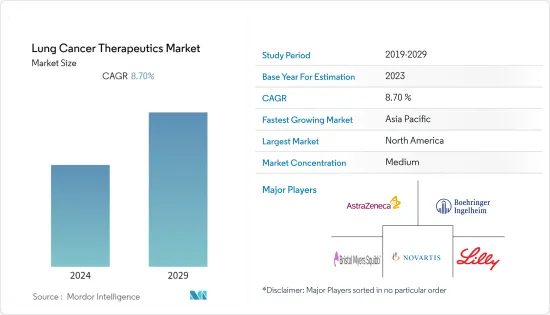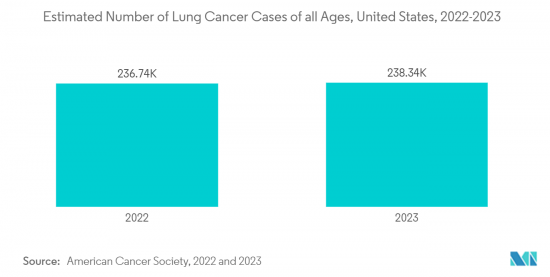 |
市場調査レポート
商品コード
1403028
肺がん治療-市場シェア分析、産業動向・統計、2024~2029年成長予測Lung Cancer Therapeutics - Market Share Analysis, Industry Trends & Statistics, Growth Forecasts 2024 - 2029 |
||||||
● お客様のご希望に応じて、既存データの加工や未掲載情報(例:国別セグメント)の追加などの対応が可能です。 詳細はお問い合わせください。
| 肺がん治療-市場シェア分析、産業動向・統計、2024~2029年成長予測 |
|
出版日: 2024年01月04日
発行: Mordor Intelligence
ページ情報: 英文 110 Pages
納期: 2~3営業日
|
- 全表示
- 概要
- 目次
肺がん治療市場は、予測期間中にCAGR 8.7%を記録すると予測されています。

肺がん患者は通常、治療中に免疫抑制剤や化学療法剤を投与されるため、SARS-CoV-2感染のリスクが高いです。パンデミックの間、肺がん患者の治療は継続的な課題となった。この課題を克服するために、さまざまな組織が提携して解決策や推奨事項を提供しました。例えば、2021年1月にJournal for Immunotherapy of Cancerが発表した論文によると、欧州放射線治療腫瘍学会と米国放射線腫瘍学会は提携し、ステージi-Ⅲの非小細胞肺がん(NSCLC)、小細胞肺がん(SCLC)に対する予防的頭蓋内照射、NSCLCに対する緩和的放射線照射に対する治療推奨を提供しました。さらに、上記の情報源によると、患者と放射線治療スタッフのリスク軽減と肺がん治療のバランスが取れた「初期のパンデミックシナリオ」と、リソースが限られており患者のトリアージが必要な「後期のパンデミックシナリオ」についての推奨が示されています。それゆえ、治療の課題を克服するためにいくつかの組織がとった取り組みが、肺がん治療の需要を増大させました。さらに、封鎖によりパンデミックの初期段階よりも治療へのアクセスが向上しているため、市場はパンデミック前のレベルの成長に達しており、予測期間中に大きく成長すると予想されます。
市場成長を促進する要因としては、肺がん有病率の増加、急速な工業化による公害の増加、喫煙者数の増加、新薬の研究開発資金の増加などが挙げられます。例えば、2022年に発表された米国がん協会(ACS)のデータによると、肺がん(小細胞がんと非小細胞がんの両方)は男女ともに2番目に多いがんであり、がんによる死亡者全体のほぼ25%を占めています。また、米国肺協会による2022年の報告書によると、この病気は依然として女性と男性のがん死亡の主要原因であるが、過去5年間の生存率は全国で21%から25%に上昇したもの、有色人種では20%と著しく低いままです。したがって、がんの有病率の増加と効果的な治療の必要性が、市場の成長に寄与すると考えられます。
さらに、主要企業による買収、提携、合併、提携も市場成長に寄与しています。例えば、2021年5月、Janssen Pharmaceuticalは、FDA承認検査で検出された上皮成長因子受容体(EGFR)エクソン20挿入変異を有し、プラチナ製剤ベースの化学療法中または化学療法後に病勢が進行した局所進行性または転移性の非小細胞肺がん(NSCLC)成人患者の治療として、RYBREVANTTM(amivantamab-vmjw)の早期承認を米国FDAが付与したと報告しました。このような製品承認も市場の成長に寄与しており、予測期間中も同様であろう。
したがって、上記の要因により、肺がん治療市場は予測期間中に成長する可能性が高いです。しかし、薬物療法の副作用や治療費の高さが市場の成長を抑制しています。
肺がん治療市場の動向
非小細胞肺がん(NSCLC)が市場の大幅な成長を維持する見込み
非小細胞肺がんは、扁平上皮がんや腺がんなど、似たような挙動を示す肺がんのグループです。NSCLCは、2つのタイプの肺がんのうちより一般的であるため、これがセグメント成長を促進すると予想されます。例えば、Cancer Treatment Centers of Americaが2022年1月に発表した論文によると、肺腺がんは肺がんの最も一般的な形態であり、全症例の30%、非小細胞肺がんの約40%を占める。同じ情報源によると、扁平上皮肺がんは非小細胞肺がん全体の約30%を占め、喫煙とよく関連しています。NSCLCのほとんどの症例では、大細胞未分化がんが全症例の10%から15%を占める。さらに、2023年に更新された米国がん学会のデータによると、一般的に肺がん全体の約80%から85%がNSCLCです。したがって、予測期間中にがん治療に対する需要が生まれる可能性が高いです。したがって、小細胞肺がんに比べてNSCLCの有病率が高いことから、このセグメント市場は予測期間中に成長すると予想されます。
さらに、主要市場参入企業による新製品の開発や上市も、セグメント別の成長を後押ししています。例えば、米国FDAは2021年10月、非小細胞肺がん(NSCLC)の一部の患者に対する手術と化学療法後の追加治療として、免疫療法薬のアテスリズマブ(テセントリク)を承認しました。非小細胞肺がん治療の最近の承認は、予測期間中の市場の成長を後押しすると思われます。
したがって、上記の要因により、このセグメントは予測期間中に成長を示すと予想されます。

北米は肺がん治療市場で大きな成長を維持する見込み
北米の肺がん治療市場は、高齢者人口と相まって肺がんに罹患する人が増加していることから、大きな市場シェアを占めると予測されています。米国がん協会の2023年報告書によると、肺がんと診断される人の多くは65歳以上です。診断される人の平均年齢は約70歳です。さらに、2022年3月のCDCの更新によると、毎年48万人以上、つまり死亡者の約5人に1人がタバコの喫煙によって死亡しています。喫煙はほぼすべての臓器にダメージを与え、肺がんと関連しています。したがって、喫煙が原因で肺がんに罹患する人の増加や高齢者人口の増加に伴い、肺がん治療に対する需要が増加し、それによって市場の成長が促進されます。
さらに、米国での製品承認も市場成長に寄与しています。例えば、2021年5月、アムジェンは、米国FDAがルマクラス(ソトラシブ)を、FDAが承認した検査により判定され、少なくとも1回の前治療が全身療法であるKRAS G12C変異の局所進行性または転移性非小細胞肺がんの成人患者の治療として承認したと発表しました。
その結果、前述のすべての要因が、予測期間中のこの地域の力強い成長に寄与すると考えられます。
肺がん治療業界概要
肺がん治療市場は、世界に事業を展開する企業だけでなく、地域的に事業を展開する企業も存在するため、その性質上、適度に集中しています。競合情勢には、AstraZeneca、Boehringer Ingelheim、Bristol-Myers Squibb Company、Eli Lilly and Company、Merck &Co.、Pfizer Inc.、Amgen Inc.、Novartis AGなど、市場シェアを持ち、よく知られている国際企業や地元企業の分析が含まれます。
その他の特典:
- エクセル形式の市場予測(ME)シート
- 3ヶ月間のアナリストサポート
目次
第1章 イントロダクション
- 調査の前提条件と市場定義
- 調査範囲
第2章 調査手法
第3章 エグゼクティブサマリー
第4章 市場力学
- 市場概要
- 市場促進要因
- 肺がんの有病率の増加
- 急速な工業化と喫煙者数の増加による汚染の増加
- 新薬の研究開発分野における資金調達の増加
- 市場抑制要因
- 薬剤の副作用
- 治療費の高騰
- ポーターのファイブフォース分析
- 新規参入業者の脅威
- 買い手/消費者の交渉力
- 供給企業の交渉力
- 代替品の脅威
- 競争企業間の敵対関係の強さ
第5章 市場セグメンテーション(市場規模-100万米ドル)
- 疾患タイプ別
- 非小細胞肺がん(NSCLC)
- 小細胞肺がん(SCLC)
- 治療法別
- 化学療法
- 放射線療法
- 免疫療法
- 標的療法
- その他の治療
- 地域
- 北米
- 米国
- カナダ
- メキシコ
- 欧州
- ドイツ
- 英国
- フランス
- イタリア
- スペイン
- その他の欧州
- アジア太平洋
- 中国
- 日本
- インド
- オーストラリア
- 韓国
- その他のアジア太平洋
- 中東・アフリカ
- GCC諸国
- 南アフリカ
- その他の中東とアフリカ
- 南米
- ブラジル
- アルゼンチン
- その他の南米
- 北米
第6章 競合情勢
- 企業プロファイル
- AstraZeneca
- Boehringer Ingelheim
- Bristol-Myers Squibb Company
- Eli Lilly and Company
- Hoffmann-La Roche
- Merck & Co.
- Pfizer Inc.
- Teva Pharmaceutical Industries Ltd.
- Abbvie(Allergan)
- Johnson & Johnson(Janssen Pharmaceuticals)
- Amgen Inc.
- Novartis AG
第7章 市場機会と今後の動向

The lung cancer therapeutics market is projected to register a CAGR of 8.7% during the forecast period.
Patients with lung cancer were at a higher risk for SARS-CoV-2 infection as they typically receive immunosuppressive and chemotherapeutic drugs during treatment. Treating patients with lung cancer during the pandemic became a continuous challenge. To overcome the challenge, various organizations partnered to provide solutions and recommendations. For instance, according to an article published by the Journal for Immunotherapy of Cancer in January 2021, the European Society for Radiotherapy and Oncology and the American Society for Radiation Oncology partnered to provide treatment recommendations for stage I-III non-small cell lung cancer (NSCLC), prophylactic cranial irradiation for small cell lung cancer (SCLC), and palliative radiation for NSCLC. Furthermore, according to the above source, recommendations were given for an 'early pandemic scenario,' where the patient and radiotherapy staff risk mitigation was balanced with lung cancer treatment, and the 'later pandemic scenario,' where resources were limited, requiring patient triage. Hence, the initiatives taken by several organizations to overcome the treatment challenge increased the demand for lung cancer therapeutics. Additionally, there is better access to treatment than in the initial pandemic phase due to the lockdown; the market has reached its pre-pandemic level growth and is expected to grow significantly over the forecast period.
Factors driving the market growth include the increasing prevalence of lung cancer, rising pollution due to rapid industrialization, growth in the number of smokers, and increasing funding for the R&D of new drugs. For instance, as per the American Cancer Society's (ACS) data published in 2022, lung cancer (both small and non-small cell) is the second most common cancer in both men and women, making up almost 25% of all cancer deaths. Besides, according to the 2022 report by the American Lung Association, while the disease remains the leading cause of cancer deaths among women and men, the survival rate over the past five years has increased from 21% nationally to 25% yet remains significantly lower among communities of color at 20%. Hence, the increasing prevalence of cancer and the need for effective treatment is likely to contribute to market growth.
Furthermore, acquisitions, partnerships, mergers, and collaborations by the key players are also contributing to the market growth. For instance, in May 2021, Janssen Pharmaceutical reported that the U.S. FDA granted the accelerated approval of RYBREVANTTM (amivantamab-vmjw) for the treatment of adult patients with locally advanced or metastatic non-small cell lung cancer (NSCLC) with epidermal growth factor receptor (EGFR) exon 20 insertion mutations, as detected by an FDA-approved test, whose disease has progressed on or after platinum-based chemotherapy. Such product approvals are also adding to the growth of the market and are likely to do the same over the forecast period.
Hence, as per the factors above, the lung cancer therapeutics market is likely to grow over the forecast period. However, the side effects of drug therapies and the high cost of the treatments have been restraining the market growth.
Lung Cancer Therapeutics Market Trends
Non-small Cell Lung Cancer (NSCLC) is Expected to Hold a Significant Growth in the Market.
Non-small cell lung cancer is a group of lung cancers that behave similarly, such as squamous cell carcinoma and adenocarcinoma. NSCLC is the more common of the two types of lung cancer and hence this is expected to drive segmental growth. For instance, as per the article published by the Cancer Treatment Centers of America in January 2022, lung adenocarcinoma is the most common form of lung cancer, accounting for 30% of all cases overall and about 40% of all non-small cell lung cancer occurrences. As per the same source, squamous cell lung cancer accounts for about 30% of all non-small cell lung cancers and is commonly associated with smoking. In most cases of NSCLC, large-cell undifferentiated carcinoma accounts for 10% to 15% of all cases. Furthermore, according to the American Cancer Society's data updated in 2023, in general, about 80% to 85% of all lung cancers are NSCLC. Hence, this is likely to create demand for cancer therapeutics over the forecast period. Therefore, with a high prevalence of NSCLC compared to small cell lung cancer, the segmental market is expected to grow over the forecast period.
Furthermore, new product developments and launches by the key market players are also boosting segmental growth. For instance, in October 2021, United States FDA approved the immunotherapy drug atezlizumab (Tecentriq) as an additional treatment after surgery and chemotherapy for some patients with non-small cell lung cancer (NSCLC). The recent approval of drugs for the treatment of non-small cell lung cancer is likely to boost the growth of the market during the forecast period.
Hence, due to the above-mentioned factors, the segment is anticipated to witness growth during the forecast period.

North America is Expected to Hold a Significant Growth in the Lung Cancer Therapeutics Market
North American lung cancer therapeutics market is projected to have a significant market share due to the increasing number of people suffering from lung cancer coupled with the geriatric population. As per the American Cancer Society 2023 report, most people diagnosed with lung cancer are 65 years or older. The average age of people when diagnosed is about 70 years. Additionally, according to the CDC update in March 2022, cigarette smoking accounted for more than 480,000 deaths every year or about 1 in 5 deaths. Smoking damages nearly every organ and is associated with lung cancer. Thus, with an increase in people suffering from lung cancer caused due to smoking and an increase in the geriatric population, the demand for lung cancer therapeutics increases, thereby driving the growth of the market.
Furthermore, product approval in the United States also contributes to market growth. For instance, in May 2021, Amgen announced that the United States FDA had approved LUMAKRAS (sotorasib) for the treatment of adult patients with KRAS G12C-mutated locally advanced or metastatic non-small cell lung cancer, as determined by an FDA-approved test, who have received at least one prior systemic therapy.
As a result, all the aforementioned factors are likely to contribute to this region's strong growth over the forecast period.
Lung Cancer Therapeutics Industry Overview
The lung cancer therapeutics market is moderately concentrated in nature due to the presence of companies operating globally as well as regionally. The competitive landscape includes an analysis of a few international as well as local companies which hold market shares and are well known including AstraZeneca, Boehringer Ingelheim, Bristol-Myers Squibb Company, Eli Lilly and Company, Merck & Co., Pfizer Inc., Amgen Inc., and Novartis AG, among others.
Additional Benefits:
- The market estimate (ME) sheet in Excel format
- 3 months of analyst support
TABLE OF CONTENTS
1 INTRODUCTION
- 1.1 Study Assumptions and Market Definition
- 1.2 Scope of the Study
2 RESEARCH METHODOLOGY
3 EXECUTIVE SUMMARY
4 MARKET DYNAMICS
- 4.1 Market Overview
- 4.2 Market Drivers
- 4.2.1 Increasing Prevalence of Lung Cancer
- 4.2.2 Rising Pollution due to Rapid Industrialization and Rise in the Number of Smokers
- 4.2.3 Increasing Funding in the Field of Research and Development of New Drugs
- 4.3 Market Restraints
- 4.3.1 Side Effects of Drugs
- 4.3.2 High Cost of Therapies
- 4.4 Porter's Five Force Analysis
- 4.4.1 Threat of New Entrants
- 4.4.2 Bargaining Power of Buyers/Consumers
- 4.4.3 Bargaining Power of Suppliers
- 4.4.4 Threat of Substitute Products
- 4.4.5 Intensity of Competitive Rivalry
5 MARKET SEGMENTATION (Market Size by Value - USD million)
- 5.1 By Disease Type
- 5.1.1 Non-small Cell Lung Cancer (NSCLC)
- 5.1.2 Small Cell Lung Cancer (SCLC)
- 5.2 By Treatment
- 5.2.1 Chemotherapy
- 5.2.2 Radiation Therapy
- 5.2.3 Immunotherapy
- 5.2.4 Targeted Therapy
- 5.2.5 Other Treatments
- 5.3 Geography
- 5.3.1 North America
- 5.3.1.1 United States
- 5.3.1.2 Canada
- 5.3.1.3 Mexico
- 5.3.2 Europe
- 5.3.2.1 Germany
- 5.3.2.2 United Kingdom
- 5.3.2.3 France
- 5.3.2.4 Italy
- 5.3.2.5 Spain
- 5.3.2.6 Rest of Europe
- 5.3.3 Asia-Pacific
- 5.3.3.1 China
- 5.3.3.2 Japan
- 5.3.3.3 India
- 5.3.3.4 Australia
- 5.3.3.5 South Korea
- 5.3.3.6 Rest of Asia-Pacific
- 5.3.4 Middle East and Africa
- 5.3.4.1 GCC
- 5.3.4.2 South Africa
- 5.3.4.3 Rest of Middle East and Africa
- 5.3.5 South America
- 5.3.5.1 Brazil
- 5.3.5.2 Argentina
- 5.3.5.3 Rest of South America
- 5.3.1 North America
6 COMPETITIVE LANDSCAPE
- 6.1 Company Profiles
- 6.1.1 AstraZeneca
- 6.1.2 Boehringer Ingelheim
- 6.1.3 Bristol-Myers Squibb Company
- 6.1.4 Eli Lilly and Company
- 6.1.5 Hoffmann-La Roche
- 6.1.6 Merck & Co.
- 6.1.7 Pfizer Inc.
- 6.1.8 Teva Pharmaceutical Industries Ltd.
- 6.1.9 Abbvie (Allergan)
- 6.1.10 Johnson & Johnson (Janssen Pharmaceuticals)
- 6.1.11 Amgen Inc.
- 6.1.12 Novartis AG
